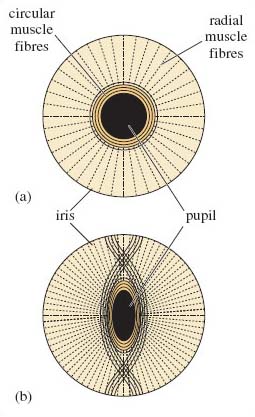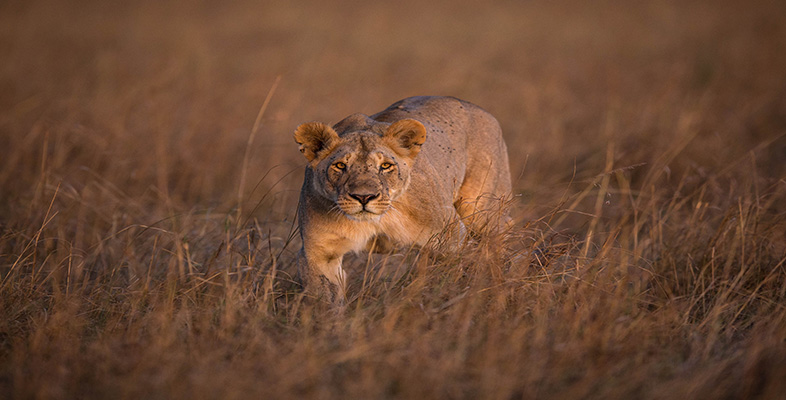3.3 Senses: vision
Vision needs to be effective to spot prey, and in many species to allow precise calculation of distances when it comes to the final pounce. In terms of success, an individual can't 'afford' too many failures; the energy expended in the chase needs to be more than compensated for by the energy gained from the food source. The most effective way of judging distance is with stereoscopic vision, i.e. an ability to see in depth, and this depends on the eyes being sufficiently far forward to allow overlap of vision from each eye.
In daylight, members of the cat family have vision that is about as effective as that of humans, but DA mentions that the vision of hunters is about six times more acute at night (the TV commentary quotes an eightfold improvement on human visual acuity for lions in the dark). Sensitivity to light on this scale depends upon getting as much light into the eye as possible through the relatively large pupil - the dark central aperture, which is circular in our own eyes. In poor light, the diameter of the pupil quickly increases, thereby gathering as much light as possible. But increased sensitivity has a price; in very bright sunshine, the amount of light has to be reduced, unless the eye is to be flooded with light. Some cats have a characteristically slit-like pupil, where, unlike our own eyes, almost complete closure of the pupil is possible.

Figure 5a is a front view of our own pupil, with the muscle fibres that control the aperture of the pupil embedded in the structure that surrounds the central pupil - the iris. There are circular muscles, running around the inner edge of the iris and radial muscles that radiate outwards. In bright light, the pupil becomes smaller via the contraction of the circular muscles and the relaxation of the radial muscles. Pupil diameter is limited by how much these circular muscles can contract - and in this arrangement, constriction can never be so pronounced as to close the pupil.
SAQ 6
Question: How is the opening of the pupil in dim light likely to be achieved?
Answer
By the relaxation of the circular muscles and the contraction of the radial muscles, causing the pupil to become larger.
The structure of the slit pupil in some cats shows a very different arrangement of circular and radial muscles (Figure 5b). Here the circular muscles are interlaced in such a way as to allow the pupil to close almost completely. But not all cats have pupils that contract to a slit; for example, the eyes of the lynx, though adapted for nocturnal vision in other respects (Figure 6b), contract to a circle. The same is true of the eyes of the large cats; as you can appreciate from the photographs in LoM, these have oval pupils, with just a hint of vertical elongation. On this evidence, there is more versatility in the more conventional pupil arrangement than meets the eye.
In our own eyes (Figure 6a) light enters through the transparent cornea, and passes through the oval-shaped lens, being bent at each stage. For an object to be sharply seen, light from it has to be bent to such an extent that it becomes focused on the light-sensitive part of the eye - the retina. In dim conditions, the amount of light focused on any one area of the retina needs to be maximised. Night hunters, such as the lynx, tend therefore to have a large pupil aperture and a relatively large lens and cornea (Figure 6b). But the rest of the eye is more modestly proportioned - a reduced retina surface area presumably ensures greater sensitivity, with more light falling on any one area. In those many carnivores (such as the puma) whose eyes are adapted to function in both night and day, the juxtaposition and relative proportions of lens, cornea and the remainder of the eye differ, resembling more those of humans (Figure 6c).

Nearly all carnivores have an extra reflecting layer, the tapetum lucidum, which is positioned outside the retina (Figure 6b and c). Its presence means that light that has passed through the retina without being absorbed and thereby stimulating the light-sensitive cells of the retina, is reflected back towards the retina, providing a 'second chance' of registering an effect [p. 144].
SAQ 7
Question: Which sequences in the TV programme reveal the presence of the tapetum lucidum in hunters?
Answer
Those of night-time hunting in lions, showing the characteristic eyeshine, which is reflected light from the tapetum. (See the programme from 29.50-33.33.) (Many nocturnal animals - and not just carnivores - have a tapetum lucidum. It also occurs in some diving mammals, enhancing their vision in the low light intensities under water.)
Other units within this series describe additional adaptations of the eye in nocturnal mammals, especially the relative abundance of the two types of light-sensitive cells in the retina. Those most reactive to low-intensity light (and unable to distinguish colour) are termed rods - as opposed to the colour-sensitive cones that function effectively only at high light intensities. As you'd expect, the retina of nocturnal carnivores, the lynx for example, is rich in rods and hence offers greatest sensitivity to light. Even the best-adapted retina contains some cones, but the capacity to see in colour is probably restricted to those relatively few carnivores that hunt in the day-time - some mongooses, for example, whose diet is sufficiently varied to include fruits and insects, where appreciating colour differences would be advantageous. Whether large hunters see colour is uncertain. Would seeing colour be helpful to large cats such as lions? For understandable reasons, this area of work is unattractive to all but the most intrepid of naturalists.
